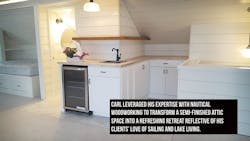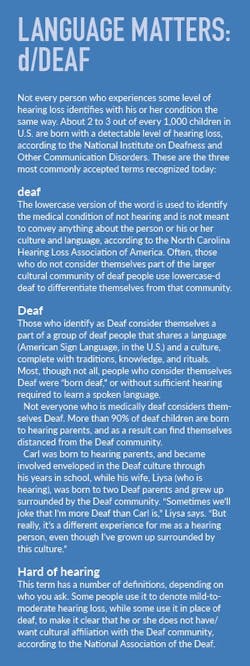Carl Callsen began tinkering with tools as soon as he was old enough to hold them. His uncle and father were both carpenters, and Callsen grew up helping his parents in their carpentry business. Today, Callsen and his wife, Liysa, own CJC Carpentry in Manitowoc, Wisc., about 80 miles north of Milwaukee.
This may sound like many other stories of someone who took his passion and turned it into a career, but Carl faces a challenge that only about 1 in 20 Americans experience: He is Deaf.
About 5% of the world’s population “suffers from disabling hearing loss,” according to the World Health Organization. In the U.S., hearing loss is more likely to be caused by genetics than any other factors.
Carl began vocational school in the early 1980s, knowing without a doubt that he wanted to take up carpentry like his dad and uncle. There, he offered guidance to the program directors on how to better equip the school for Deaf students. “Having the same interpreter with the same student for their entire time at the school is a huge help, because it’s hard when you get an interpreter who isn’t familiar with construction and the terminology,” he says. “I also made it a habit to ask for printed materials before classes, so that I could review them ahead of time. It’s almost impossible to look at any reading material while trying to watch the interpreter.”
Building the CJC Team
Carl and Liysa met like so many couples do: at a bar. But the circumstances were unique. Liysa, who grew up in Detroit with two Deaf parents, moved to Chicago and missed her connection to that community. “I grew up surrounded by the Deaf community, and when I moved, I lost that,” she says. “I wanted to build that connection again, and started training to become an interpreter.”
As part of that training, Liysa attended events geared toward the Deaf community, one of which included a monthly get-together at a suburban bar. She expected to meet people around her parents’ age, but instead found a younger crowd. “I noticed one man across the bar, we kept making eye contact, and eventually a friend introduced us,” Liysa says. “So I met Carl, and the rest is history.” They’ve been married for 18 years and running CJC Carpentry for five.
As a small, family-owned business, Carl and Liysa make up the team. They sub out tasks when necessary, but Carl prefers to complete most jobs himself. “About two years ago, Carl realized he needed more hands on deck but wasn’t ready to hire anyone else,” Liysa says, “so he taught me instead. Now I’ll help with drywalling, cutting and placing tile, and other odds and ends.”
Carl began vocational school in the early 1980s, knowing without a doubt that he wanted to take up carpentry like his dad and uncle.
Running the Business
After vocational school and an apprenticeship with a local union, Carl accepted a job with the Burger Boat Company, a custom yacht builder in Manitowoc. There, he learned how to work with exotic woods and gained the techniques that he’s well-known for today: creating beautifully smooth, curved woodworking and crafting pieces without the use of nails.
It’s clear, when interacting with Carl and Liysa together or separately, that their teamwork and love for the projects fuels CJC’s success. “I joke with clients that Carl loves their project more than he loves me,” Liysa says, laughing. “He puts in the same amount of care and attention that he would for a personal project, because every project is personal for him.”
About 50% of CJC’s business is repeat customers, 40% is renewals, and 10% is miscellaneous leads. The projects are small, and annual revenue in 2018 was about $300K. Last year, they opened a professional woodworking shop with an eye toward expansion. The company does a variety of projects, although trimwork and woodwork on boats are Carl’s specialties. “Right now, we’re doing all the woodwork in a 100-foot vessel in Michigan,” Liysa says.
When a new lead comes in, CJC treats it like any other company: They follow up, meet with the potential client, and get the ball rolling. “We don’t usually mention that Carl is Deaf before we meet with a lead,” says Liysa. “Sometimes when people first notice, they’ll pause, but very rarely does anyone make it an issue. People know his work is good, and they know we’re a good business—that’s what matters to them.”
Thanks to her experience with her parents and her training as an interpreter, Liysa helps bridge the communication gap when necessary. But Carl, like many people who are Deaf, does not view his deafness as a disability. “Hearing people rely on their ears, instead of their eyes,” he says. “They’re not trained to scan like Deaf people are, and so it’s harder to anticipate when something is going to happen if you aren’t looking for it.”
He has encountered coworkers in previous jobs who thought he was using his deafness to gain an edge. “A lot of jobsites have a no-phones policy, but I use the phone to communicate,” Carl says. “Some people saw that as special treatment, and would try to get me in trouble. But it never turned into a bigger problem.”
Communicating on a jobsite might be different for someone who is Deaf, but it’s not at all impossible. “People will forget from time to time that I can’t hear them, so they’ll start talking with their backs to me,” Carl says. “I have to stop them and ask them to repeat, but most people have no problem accommodating.”
He’s also taken to writing notes on building material rather than paper when he needs to communicate through something other than sign language on the jobsite. “I’ll lose paper almost immediately,” he says. “But 2x4s and framing are always around, and it adds a fun piece of evidence that we were there. Don’t worry though—I draw the line at drywall.”
Giving Back
Carl taught Liysa some hands-on skills so she could help the business, and Liysa now gets to return the favor. As the company continues to build success, the pair wants to devote more time to speaking engagements. “Carl has so much knowledge to share, not only about carpentry, but also about diversity in the workplace, overcoming obstacles, figuring out what path you want your career to take,” Liysa says. “It’s fun to be the one who gets to help him learn how to share that with others.”
She uses her background in communications to give Carl pointers on improving his public speaking, and he now has a few speaking engagements under his belt, including one at the Wisconsin School for the Deaf. “I love talking to others in the Deaf community and people who want to better understand what it’s like to be Deaf, but I’d really like to reach the parents of Deaf children,” Carl says. “I want them to see that I’m successful and that their kids can do it, too.”
The pair views speaking to communities as multipurpose: They can promote the trades to students and other young men and women, while also educating about the importance of diversity and inclusion in the workplace. “Many people out there have never met someone who is Deaf,” says Liysa. “Getting to see Carl speak animatedly in front of a crowd about what he’s most passionate about lets them see that deafness isn’t a disability, and it’s not keeping him from doing what he loves.”
About the Author

Kaitlin Schuler
Kaitlin Schuler is the special projects editor for Pro Remodeler.


